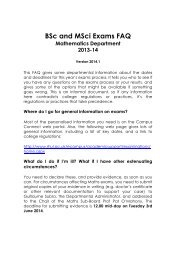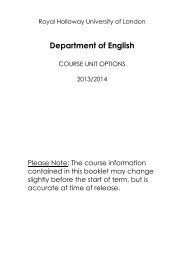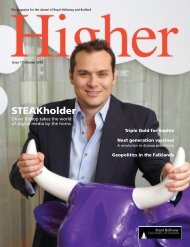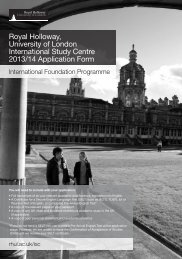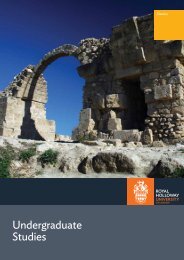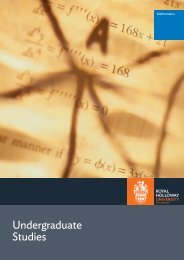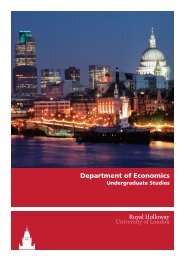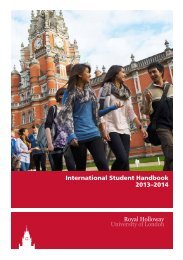Department of Physics - Royal Holloway, University of London
Department of Physics - Royal Holloway, University of London
Department of Physics - Royal Holloway, University of London
Create successful ePaper yourself
Turn your PDF publications into a flip-book with our unique Google optimized e-Paper software.
Academic staff and their research<br />
A full list <strong>of</strong> staff in the department and their research interests can be<br />
found at http://www.rhul.ac.uk/physics/staffdirectory<br />
Dr Vladimir Antonov, Reader in Nanophysics<br />
Specialising in Nanoelectronics, Dr Antonov’s research is concerned<br />
with the study <strong>of</strong> low-dimensional structures, including research on<br />
quantum bit devices, TeraHertz detectors and novel nanodevices.<br />
Dr Tracey Berry, Senior Lecturer in Particle <strong>Physics</strong><br />
Dr Berry’s research interests are in searching for new <strong>Physics</strong>, especially<br />
extra dimensions, at the highest energies possible. She has worked at<br />
the Tevatron Collider at FermiLab (Illinois, USA) and is involved in the<br />
analysis <strong>of</strong> new results from the ATLAS detector, at the Large Hadron<br />
Collider at CERN.<br />
Dr Veronique Boisvert, Admissions Tutor and Senior<br />
Lecturer in Particle <strong>Physics</strong><br />
Dr Boisvert’s principal areas <strong>of</strong> research are in quark physics, the<br />
question <strong>of</strong> why there is more matter than antimatter in the universe<br />
and the physics that may link the top quark with the Higgs Boson (the<br />
probable mechanism for the fundamental particles to have mass). She<br />
has worked at Fermilab and CERN.<br />
Dr Stewart Boogert, Reader in Particle <strong>Physics</strong><br />
Dr Boogert’s interests include the aspects <strong>of</strong> the design <strong>of</strong> a linear<br />
accelerator that affect its important physics goals. These include<br />
measurement <strong>of</strong> the Luminosity spectrum and the effect on the<br />
measurement <strong>of</strong> the top mass from threshold scans. He has close<br />
research links with the <strong>University</strong> <strong>of</strong> Oxford through the John Adams<br />
Institute and with collaborators in Japan.<br />
Dr Andrew Casey, Lecturer in Low Temperature <strong>Physics</strong><br />
Dr Casey is presently an EPSRC Advanced Research Fellow, a<br />
prestigious appointment allowing time for pure research. His research<br />
interests involve the study <strong>of</strong> fundamental quantum effects in<br />
superfluids and the development <strong>of</strong> nuclear magnetic spectroscopy<br />
for BioDiagnostic uses, including developing a new generation <strong>of</strong> MRI<br />
machines.<br />
Pr<strong>of</strong>essor Brian Cowan, Pr<strong>of</strong>essor <strong>of</strong> Low Temperature<br />
<strong>Physics</strong> and Head <strong>of</strong> <strong>Department</strong><br />
Pr<strong>of</strong> Cowan’s special interest is in Nuclear Magnetic Resonance and<br />
Low Temperature <strong>Physics</strong> and concerns the properties <strong>of</strong> both solid<br />
and liquid helium. His work involves the study <strong>of</strong> 2-dimensional<br />
and 3-dimensional properties, the development <strong>of</strong> high sensitivity<br />
electronic instrumentation and the theory <strong>of</strong> magnetic relaxation.<br />
Pr<strong>of</strong>essor Glen Cowan, Pr<strong>of</strong>essor <strong>of</strong> Particle <strong>Physics</strong><br />
Dr Cowan has worked on the BaBar experiment at the Stanford Linear<br />
Accelerator (SLAC) and is now involved in the ATLAS experiment at<br />
CERN. His interests include hadron production in electron-positron<br />
collisions as well as developing advanced methods <strong>of</strong> statistical data<br />
analysis.<br />
Pr<strong>of</strong>essor Matthias Eschrig, Pr<strong>of</strong>essor <strong>of</strong> Theoretical<br />
<strong>Physics</strong><br />
Dr Eschrig is a member <strong>of</strong> the Hubbard Theory Consortium and<br />
a SEPnet fellow. He is active in bringing together experimental<br />
and theoretical efforts in the department and partner institutions,<br />
including the Rutherford Appleton Laboratory and the <strong>London</strong> Centre<br />
<strong>of</strong> Nanotechnology. His principal interests are in the fields <strong>of</strong> quantum<br />
many-body physics, emergent topological excitations, mesoscopic<br />
transport phenomena, and superconducting nano-devices.<br />
Dr Stuart Flockton, Senior Lecturer in <strong>Physics</strong><br />
Dr Flockton’s research interests are in adaptive systems, including<br />
the design <strong>of</strong> electrical circuits using artificial evolution and the<br />
development <strong>of</strong> sophisticated methods to extract overlapping signals<br />
from mixtures.<br />
Dr Stephen Gibson, Lecturer in Accelerator <strong>Physics</strong><br />
Dr Gibson is a member <strong>of</strong> the John Adams Institute for Accelerator<br />
Science (a joint venture between <strong>Royal</strong> <strong>Holloway</strong> <strong>University</strong> and the<br />
<strong>University</strong> <strong>of</strong> Oxford.) His principal interests lie in the development <strong>of</strong><br />
future generations <strong>of</strong> particle accelerators and detectors.<br />
Pr<strong>of</strong>essor Jon G<strong>of</strong>f, Pr<strong>of</strong>essor <strong>of</strong> Quantum Matter<br />
Pr<strong>of</strong>essor G<strong>of</strong>f’s main interests are in the use <strong>of</strong> neutron and<br />
synchrotron x-ray beams to study how quantum behaviour underpins<br />
the physics <strong>of</strong> novel metals, frustrated magnetism, fabricated<br />
multilayer materials and other condensed states <strong>of</strong> matter. His research<br />
takes him to the new world-class UK ISIS and Diamond facilities, as<br />
well as a number <strong>of</strong> other international laboratories.<br />
Dr John Hargreaves, Senior Lecturer in Astrophysics<br />
Dr Hargreaves is investigating cosmological models with extra<br />
dimensions. He is also interested in non-minimal models <strong>of</strong> the<br />
universe.<br />
Dr Andrew Ho, Lecturer in Theoretical <strong>Physics</strong>.<br />
An EPSRC Advanced Research Fellow, his principal interests are in the<br />
study <strong>of</strong> quantum many-body <strong>Physics</strong> and especially mechanisms that<br />
destabilise the standard ‘Fermi liquid’ picture <strong>of</strong> a metal. He has also<br />
focused more recently on theories <strong>of</strong> strong correlation in cold atom<br />
traps.<br />
Dr Grégoire Ithier, Lecturer in Quantum Information<br />
As a member <strong>of</strong> the Quantum Devices group, Dr Ithier’s research<br />
exploits quantum mechanics in the development <strong>of</strong> the world’s best<br />
amplifiers and detectors. Through the use <strong>of</strong> nan<strong>of</strong>abricated devices,<br />
cryogenics and superconducting materials, he is also testing the use <strong>of</strong><br />
quantum mechanics in hitherto unexplored regimes.<br />
Dr Pavel Karataev, Senior Lecturer in Particle <strong>Physics</strong><br />
Dr Karataev has worked in Tomsk, Russia and Tokyo, Japan before<br />
recently joining <strong>Royal</strong> <strong>Holloway</strong>. His principal research interests are in<br />
the development <strong>of</strong> charged particle beam diagnostic techniques for<br />
future particle physics experiments, including the LaserWire project at<br />
the KEK Accelerator test facility (Japan).<br />
26





